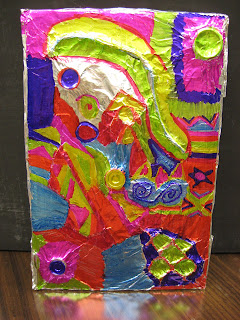Mix-It-Up Abstract
Lesson Objective: SWBAT work in pairs to create an abstract tiled watercolor painting.
Skill to be Mastered: To collaborate with each other in using watercolor techniques to create two paintings to be cut into tiles and rearranged to produce an abstract tiled painting.
I Can Statement: I can work with a partner to design and produce a watercolor tiled abstract piece of art.
Teaching Strategy: I start this project by showing students different examples of abstract paintings in a PowerPoint Presentation, like Picasso and Braque. After the presentation I will put them in pairs and have them paint an abstract painting using watercolor and sharpie (to make certain areas more defined or just for looks). I will not tell them at first that they will be cutting up their paintings to ensure that they give their best effort. I will model how to measure 1-2 inch squares on their paintings before they cut them out. I will use guided practice to make sure they are following all instructions and to make sure they are working with their partners and not doing it all on their own. I will also explain how they will be graded on the project and that if one student does all the work on the project it will affect the other students grade in a negative way. I explain that the work is to be done equally.
Materials:
12x18 drawing paper
12x18 black construction paper
Pencil
Watercolor paint
Paintbrush
Water cup
Paper towels
Sharpie markers
Scissors
Glue
Instructions:
1. Decide as a pair what colors you want your end piece to be.
2. Paint an abstract painting on 12x18 paper.
3. Use sharpie after painting dries to enhance look.
4. Measure out 2 inch even squares on paper and cut out.
5. Mix up the squares with your partner and rearrange onto black construction paper.
6. Use Glitter glue in between each piece to look like glitter frames.
Materials:
12x18 drawing paper
12x18 black construction paper
Pencil
Watercolor paint
Paintbrush
Water cup
Paper towels
Sharpie markers
Scissors
Glue
Instructions:
1. Decide as a pair what colors you want your end piece to be.
2. Paint an abstract painting on 12x18 paper.
3. Use sharpie after painting dries to enhance look.
4. Measure out 2 inch even squares on paper and cut out.
5. Mix up the squares with your partner and rearrange onto black construction paper.
6. Use Glitter glue in between each piece to look like glitter frames.



